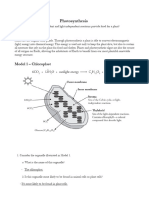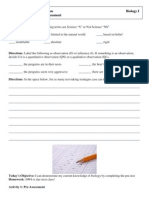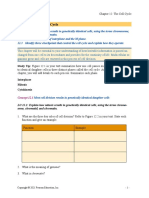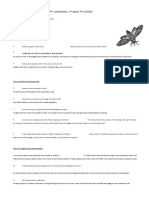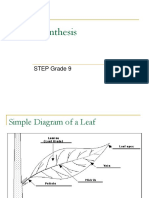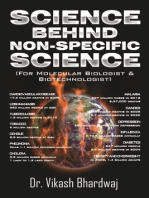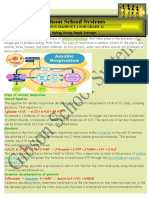Biology Chapter 13 Photosynthesis
Biology Chapter 13 Photosynthesis
Uploaded by
Sokuntheary SrunCopyright:
Available Formats
Biology Chapter 13 Photosynthesis
Biology Chapter 13 Photosynthesis
Uploaded by
Sokuntheary SrunOriginal Title
Copyright
Available Formats
Share this document
Did you find this document useful?
Is this content inappropriate?
Copyright:
Available Formats
Biology Chapter 13 Photosynthesis
Biology Chapter 13 Photosynthesis
Uploaded by
Sokuntheary SrunCopyright:
Available Formats
🌱
BIOLOGY CHAPTER 13:
PHOTOSYNTHESIS
Class
Created Dec 27, 2020 1222 PM
Materials
Property
Reviewed
Type
Chapter 13: Photosynthesis
What is photosynthesis?
→ Photosynthesis is a reaction in which light energy is converted to chemical
energy in the form of glucose. Oxygen is a waste product of this reaction and is
released into the atmosphere.
BIOLOGY CHAPTER 13 PHOTOSYNTHESIS 1
→ Occurs in chloroplasts
Two Stages of Photosynthesis
In the light dependent photosynthesis stage, the energy from the Sun hits
chlorophyll in the thylakoid membranes, water is split into hydrogen ions and
oxygen as a waste. Hydrogen ions is used to make ATP and NADPH which will
then be passed on to the light independent stage where it does not require any
light, the Calvin Cycle involved in will then take CO2 from the atmosphere and
uses the energy from ATP and NADPH to produce glucose.
1. The Light Depedent Reactions
→ Takes place on the thylakoids of the chloroplasts
Non-cyclic Photophosphorylation:
Involves both photosystem 1 and 2
Light hits the chlorophyll inside photosystem 2, the chlorophyll starts
vibrating and if it vibrates enough, that energy will be passed into its electron
That electron will become free from the chlorophyll molecule and that excited
electron moves up to a higher energy level and passed down an electron
transport chain, losing its energy as it goes
This energy is used to pump hydrogen ions across from the stroma into the
lumen of the thylakoids.
The electron then arrives to photosystem 1, however the electron has lost its
energy and it needs more light to re-excite that electron back up to a higher
energy level
It then gets eventually gets passed along down another electron transport
chain until it combines with NADP and results in NADPH
Now that we have lost an electron, water will be broken down through the
process of photolysis into an electron in photosystem 2, more hydrogen ions
and water as a waste product as it diffuses out of the cell.
BIOLOGY CHAPTER 13 PHOTOSYNTHESIS 2
The concentrated hydrogen will then pass down the electrical chemical
gradient through ATP synthase turning ADP and phosphate into ATP.
→ Requires ADP and NADP for it to work, however too much sunlight exposure at
the end of a long day, the plant might be short in NADP, in this case it can switch
to an alternative to Cyclic Photophosphorylation.
Cyclic Photophosphorylation:
Starts off like Non-Cyclic up until the electron reaches photosystem 1
Since there is no NADP for the electron to be accepted, so this electron will
be passed all the way back to photosystem 2
It will get re-excited, passed back along, generating more hydrogen ions into
the lumen which can go through ATP synthase and generate ATP
Through this process, water is not needed because no replacement of
electron is required, no NADPH produced since there's no NADP, makes more
ATP, basically recycling the same electron over and over again.
2. The Light Independent Reactions
→ AKA The Calvin Cycle(dark reaction), is the final stage of photosynthesis which
does not require light, uses the ATP and NADPH from the light dependent stage
to produce glucose.
→ Occurs in the stroma of the chloroplasts.
There are 4 stages in the Calvin Cycle:
Carbon fixation:
RuBP5 Carbon sugar) combines with CO2 in a reaction called carbon fixation
catalyzed by the enzyme RUBISCO to give two molecules of glycerate 3
phosphate(three carbon compound)/ GP
Reduction Phase:
Each Gp molecule will then be reduced by NADPH and ATP to triose phosphate.
BIOLOGY CHAPTER 13 PHOTOSYNTHESIS 3
Carbohydrate Formation:
1/6 of the triose phospshate is used to make glucose(every 6 cycles of the
Calvin cycle) which is then converted to essential organic compounds such as
polysaccharides, lipids, amino acids and nucleic acids.
Regeneration Phase:
The remaining 5/6 of the triose phosphates are used to regenerate RuBP.
Factors Necessary for Photosynthesis
→ The rate of photosynthesis is determined by limiting factors such as CO2
concentration, light intensity, light wavelength and temperature.
The rate of photosynthesis increases as these factors increases
However, at high light intensities and temperatures, the leaves can be
damaged and enzymes denature, this the rate is slowed.
C4 Plants
→ C4 Photosynthesis takes place in both the mesophyll cells and the bundle
sheath cells:
PEP reacts with carbon dioxide with the help of the enzyme PEP carboxylase
and forms a 4 carbon molecule called oxaloacetate which will then be
converted into malate(4C)
Malate would then be decarboxylated and turns into a pyruvate of 3C
Meanwhile the CO2 that has been removed from malate diffuses from the
mesophyll cells into the bundle sheath cells will be passed to RuBP catalyzed
by rubisco where the Calvin cycle starts and sugar is produced.
Photorespiration
BIOLOGY CHAPTER 13 PHOTOSYNTHESIS 4
When RuBP binds with O2 instead of CO2
What happens during hot/dry season or environment?
Stomata closes to prevent water loss/dehydration
CO2 needed for light-independent reactions cannot enter
O2 needed for light-dependent reactions cannot leave
At high O2 concentration levels, rubisco attaches to O2 instead of CO2
CO2 is produced rather than fixed
The differences between C3 and C4 plants:
C3 Plants
The mesophyll cells are packed loosely throughout the leaf
Photosynthesis occurs only in the mesophyll cells
CO2 molecule acceptor is RuBP
The optimum temperature is 2025 degrees celsius (coursebook says 30
Higher chances of photorespiration in C3 plants
Stomata remains open even when they are being exposed to high
temperature
The first stable compound is the "3 phospho glyceric acid(PGA)"
Examples: Rice and Sunflowers are C3 plants
C4 Plants
Mesophyll cells are wrapped tightly around the vascular bundle in a ring-like
form
BIOLOGY CHAPTER 13 PHOTOSYNTHESIS 5
Photosynthesis occurs in both mesophyll and bundle sheath cells
CO2 molecule acceptor is PEPPhosphoenolpyruvate)
The optimum temperature is 3544 degrees celsius (coursebook says 45
Photorespiration does not happen at all
Stomata closes to prevent dehydration
The first stable compound is the 4C molecule called "oxaloacetate"
Examples: Sugarcane and Maize or corn are C4 plants.
BIOLOGY CHAPTER 13 PHOTOSYNTHESIS 6
Trapping Light Energy
→ Chloroplasts contain several different pigments, and these different pigments
absorb different specific wavelengths of light.
Having multiple pigments allows the organism to capture more energy from the
Sun, compared to having just one pigment.
→ The photosynthetic pigments of higher plants form two groups:
Chlorophylls (primary pigments):
Chlorophyll a (yellow-green): absorbs light at 430nm and 663nm, is found
in all photosynthetic plants
Chlorophyll b (blue-green): absorbs light at 453nm-642nm
Carotenoids (accessory pigments):
β carotene (orange)
Xanthophyll (yellow)
BIOLOGY CHAPTER 13 PHOTOSYNTHESIS 7
→ Chlorophylls absorb mainly in the red and blue-violet regions of the light
spectrum. They reflect green light, which is why plants look green
→ An absorption spectrum: Is a graph of the absorbance of different
wavelengths of light by a pigment.
→ An action spectrum: Is a graph of the rate of photosynthesis at different
wavelengths of light.
→ The shorter the wavelength, the greater the energy it contains.
→ The technique used to separate chloroplast pigments is called
Chromatography.
BIOLOGY CHAPTER 13 PHOTOSYNTHESIS 8
You might also like
- Learners Activity Sheet in General Biology 1: "Cellular Respiration"No ratings yetLearners Activity Sheet in General Biology 1: "Cellular Respiration"2 pages
- 2.7 Cell Division Going Wrong - Cancer-SNC2D0% (1)2.7 Cell Division Going Wrong - Cancer-SNC2D2 pages
- (Photosynthesis and Cellular Respiration) : What I Know (Pre Test)No ratings yet(Photosynthesis and Cellular Respiration) : What I Know (Pre Test)16 pages
- Karyotyping: Prof. Dr. Muhammad Wajid Director IPAZ/SABNo ratings yetKaryotyping: Prof. Dr. Muhammad Wajid Director IPAZ/SAB20 pages
- Cellular Respiration: Chemical Bonds GlucoseNo ratings yetCellular Respiration: Chemical Bonds Glucose10 pages
- Unit 1: Scientific Investigation Biology I Daysheet 6: Biology Pre-Assessment BellringerNo ratings yetUnit 1: Scientific Investigation Biology I Daysheet 6: Biology Pre-Assessment Bellringer6 pages
- Bio 12 Plo b9 and b10 Transport Across Cell Membrane Vocabulary SolutionsNo ratings yetBio 12 Plo b9 and b10 Transport Across Cell Membrane Vocabulary Solutions4 pages
- Laboratory Manual: Biochemistry I (BIO202) : Virtual University of PakistanNo ratings yetLaboratory Manual: Biochemistry I (BIO202) : Virtual University of Pakistan20 pages
- Crash Course Chemistry 22 Atomic Hook-Ups BlankNo ratings yetCrash Course Chemistry 22 Atomic Hook-Ups Blank1 page
- IB - MYP5 U6 How Docharacteristics Pass From One Generation To AnotherNo ratings yetIB - MYP5 U6 How Docharacteristics Pass From One Generation To Another77 pages
- Summary Notes - Topic 17 Inheritance - CIE Biology IGCSENo ratings yetSummary Notes - Topic 17 Inheritance - CIE Biology IGCSE5 pages
- IB MYP U7 Peppered Moth Activity SolutionsNo ratings yetIB MYP U7 Peppered Moth Activity Solutions2 pages
- AP Biology Practice Enzyme FRQ Last Name: - First Name: - Per. - + /12No ratings yetAP Biology Practice Enzyme FRQ Last Name: - First Name: - Per. - + /124 pages
- Science behind Non-specific Science: (For Molecular Biologist & Biotechnologist)From EverandScience behind Non-specific Science: (For Molecular Biologist & Biotechnologist)No ratings yet
- Herbicide - Photosynthesis & Pigment Synthesis InhibitorsNo ratings yetHerbicide - Photosynthesis & Pigment Synthesis Inhibitors4 pages
- System Physiology - Plant Unit 6 Csir Net Life Sciences Best CoachingNo ratings yetSystem Physiology - Plant Unit 6 Csir Net Life Sciences Best Coaching142 pages
- Unit 3 Note Set 4 AP Biology Photosynthesis Part 2No ratings yetUnit 3 Note Set 4 AP Biology Photosynthesis Part 23 pages
- Lab 4 - Introduction and Protocol - F2024No ratings yetLab 4 - Introduction and Protocol - F202414 pages
- Isolation of Chloroplast and Its ActivityNo ratings yetIsolation of Chloroplast and Its Activity6 pages
- Baker. Chlorophyll Fluoresncence, A Probe of Photosynthesis in Vivo0% (1)Baker. Chlorophyll Fluoresncence, A Probe of Photosynthesis in Vivo28 pages
- Patterns of Electron Flow Through Light Reaction EventsNo ratings yetPatterns of Electron Flow Through Light Reaction Events27 pages
- Worksheet - 01 - Photosynthesis in Higher Plants - BotanyNo ratings yetWorksheet - 01 - Photosynthesis in Higher Plants - Botany3 pages
- Learners Activity Sheet in General Biology 1: "Cellular Respiration"Learners Activity Sheet in General Biology 1: "Cellular Respiration"
- (Photosynthesis and Cellular Respiration) : What I Know (Pre Test)(Photosynthesis and Cellular Respiration) : What I Know (Pre Test)
- Karyotyping: Prof. Dr. Muhammad Wajid Director IPAZ/SABKaryotyping: Prof. Dr. Muhammad Wajid Director IPAZ/SAB
- Unit 1: Scientific Investigation Biology I Daysheet 6: Biology Pre-Assessment BellringerUnit 1: Scientific Investigation Biology I Daysheet 6: Biology Pre-Assessment Bellringer
- Bio 12 Plo b9 and b10 Transport Across Cell Membrane Vocabulary SolutionsBio 12 Plo b9 and b10 Transport Across Cell Membrane Vocabulary Solutions
- Laboratory Manual: Biochemistry I (BIO202) : Virtual University of PakistanLaboratory Manual: Biochemistry I (BIO202) : Virtual University of Pakistan
- IB - MYP5 U6 How Docharacteristics Pass From One Generation To AnotherIB - MYP5 U6 How Docharacteristics Pass From One Generation To Another
- Summary Notes - Topic 17 Inheritance - CIE Biology IGCSESummary Notes - Topic 17 Inheritance - CIE Biology IGCSE
- AP Biology Practice Enzyme FRQ Last Name: - First Name: - Per. - + /12AP Biology Practice Enzyme FRQ Last Name: - First Name: - Per. - + /12
- Science behind Non-specific Science: (For Molecular Biologist & Biotechnologist)From EverandScience behind Non-specific Science: (For Molecular Biologist & Biotechnologist)
- Herbicide - Photosynthesis & Pigment Synthesis InhibitorsHerbicide - Photosynthesis & Pigment Synthesis Inhibitors
- System Physiology - Plant Unit 6 Csir Net Life Sciences Best CoachingSystem Physiology - Plant Unit 6 Csir Net Life Sciences Best Coaching
- Unit 3 Note Set 4 AP Biology Photosynthesis Part 2Unit 3 Note Set 4 AP Biology Photosynthesis Part 2
- Baker. Chlorophyll Fluoresncence, A Probe of Photosynthesis in VivoBaker. Chlorophyll Fluoresncence, A Probe of Photosynthesis in Vivo
- Patterns of Electron Flow Through Light Reaction EventsPatterns of Electron Flow Through Light Reaction Events
- Worksheet - 01 - Photosynthesis in Higher Plants - BotanyWorksheet - 01 - Photosynthesis in Higher Plants - Botany






















